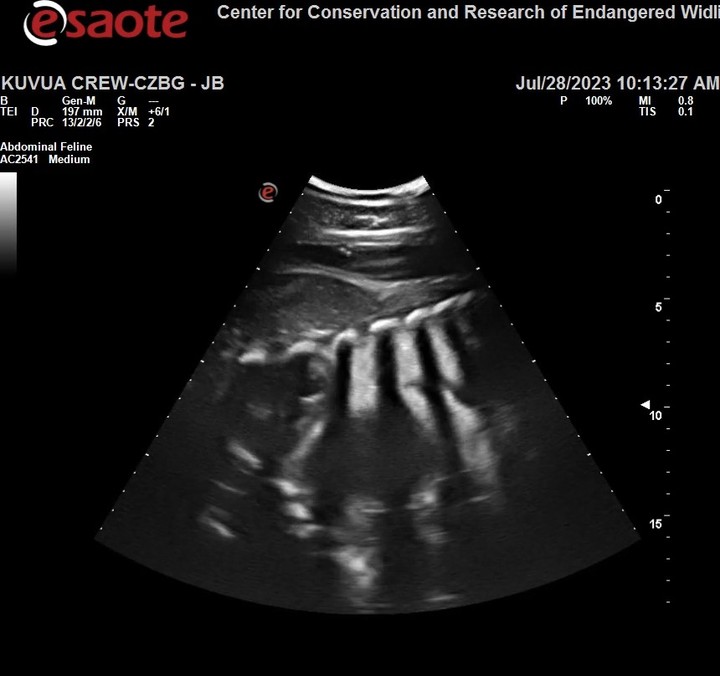Summary:
– The London Zoo is working on using positive reinforcement to train animals.
– They are also using transabdominal ultrasounds to track Okapi pregnancies.
– The Cincinnati Zoo is helping monitor an expecting mother, Okapi, named Kauvu.
– The zookeeper staff worked on getting Kauvu comfortable with ultrasounds before her pregnancy.
– Dr. Julie Barnes from CREW performs ultrasounds bi-weekly to assess fetal health and development.
The London Zoo, known for its dedication to animal welfare and conservation, is pioneering new techniques to improve the well-being of its residents. One fascinating approach they are exploring is the use of positive reinforcement training. By using rewards and encouragement, the zookeepers can teach the animals new behaviors that benefit their health and happiness.
The concept of positive reinforcement training is not a new one. It has been successfully adopted in many fields, including dog training and dolphin shows. However, applying this technique to diverse zoo animals presents its unique challenges. The London Zoo staff, however, is determined to make a difference.
The benefits of positive reinforcement training are numerous. Firstly, it allows animals to actively participate in their care and well-being. By teaching them to voluntarily participate in medical procedures, such as routine check-ups or administration of medications, the animals experience less stress and discomfort. This, in turn, makes it easier for zookeepers and veterinarians to provide the necessary care without causing unnecessary distress to the animals.
One of the London Zoo’s recent endeavors is using positive reinforcement training to acclimate Okapi, a rare and endangered species, to transabdominal ultrasounds. These ultrasounds are crucial in tracking Okapi pregnancies and monitoring the health and development of the fetus. By using positive reinforcement techniques, the zookeepers were able to build trust with the Okapi and make the ultrasound process less invasive and stressful.
To further their research and standardize the procedures, the London Zoo contacted other zoos for assistance. The Cincinnati Zoo stepped up to the challenge and offered to help monitor their expecting mother, Okapi, Kauvu. The keeper staff at Cincinnati Zoo had already been working on getting Kauvu comfortable with transabdominal ultrasounds even before her pregnancy. This prior training made the process much smoother and less stressful for Kauvu and the staff involved.
Dr. Julie Barnes, a veterinarian at the Center for Conservation and Research of Endangered Wildlife (CREW), has been closely involved in performing bi-weekly ultrasounds on Kauvu to assess fetal health and development. This collaborative effort between the London Zoo, Cincinnati Zoo, and CREW showcases the power of cooperation in advancing animal welfare practices and conservation efforts.
The use of positive reinforcement training and transabdominal ultrasounds not only benefits the Okapi population but also contributes to our understanding of reproductive biology in this endangered species. By regularly monitoring pregnancies and tracking the development of the fetus, scientists and conservationists can gain valuable insights into the reproductive patterns and overall health of the animals.
The successful adoption of positive reinforcement training and the use of transabdominal ultrasounds in tracking Okapi pregnancies is a testament to the dedication and innovation of zoos and wildlife conservation organizations. It is heartening to see how these institutions constantly strive to improve the lives of the animals under their care and contribute to protecting endangered species.
As we learn more about animal behavior and welfare, we must continue to support and encourage these efforts. The London Zoo, the Cincinnati Zoo, and organizations like CREW are setting an inspiring example for others to follow. By working together and sharing knowledge, we can make significant strides in zoology and contribute to preserving our planet’s incredible wildlife.
So next time you visit a zoo, take a moment to appreciate the hard work and dedication that goes into the care of these animals. Behind the scenes are teams of passionate individuals working tirelessly to ensure the well-being of every resident. The collaboration between the London Zoo, the Cincinnati Zoo, and CREW is just one example of the incredible achievements we can make when we come together to protect and conserve our precious wildlife.
*****
Source Description
The London Zoo is currently working on changing this by using positive reinforcement transabdominal ultrasounds to track Okapi pregnancies. They have asked other zoos to help, and Cincinnati Zoo has stepped up to the challenge with frequent monitoring of our expecting mother, Kauvu. Keeper staff had worked with getting Kauvu comfortable with transabdominal ultrasounds well before her pregnancy, and Dr. Julie Barnes, a veterinarian a CREW (Center for Conservation and Research of Endangered Wildlife), has been performing bi-weekly ultrasounds to assess fetal health and development.


